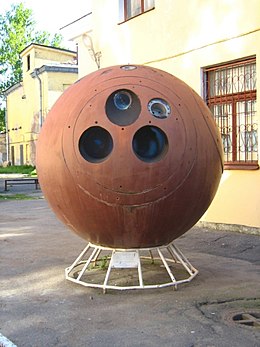 A Zenit reentry capsule A Zenit reentry capsule | |
| Names | Zenit 2-33 |
|---|---|
| Mission type | Optical imaging reconnaissance |
| Operator | OKB-1 |
| COSPAR ID | 1966-001A |
| SATCAT no. | 1903 |
| Mission duration | 8 days |
| Spacecraft properties | |
| Spacecraft type | Zenit-2 |
| Manufacturer | OKB-1 |
| Launch mass | 4730 kg |
| Start of mission | |
| Launch date | 7 January 1966 08:24:00 GMT |
| Rocket | Vostok-2 |
| Launch site | Baikonur 31/6 |
| Contractor | OKB-1 |
| End of mission | |
| Disposal | Recovered |
| Landing date | 15 January 1966 |
| Orbital parameters | |
| Reference system | Geocentric |
| Regime | Low Earth |
| Perigee altitude | 193 km |
| Apogee altitude | 380 km |
| Inclination | 65.0° |
| Period | 90.2 minutes |
| Epoch | 7 January 1966 |
| Zenit programme Zenit-2← Zenit 2-32Zenit 2-34 → Kosmos (satellites)← Kosmos 103Kosmos 105 → | |
Kosmos 104 (Космос 104 meaning Cosmos 104) or Zenit-2 No.33 was a Soviet first-generation low-resolution optical film–return reconnaissance satellite launched in 1966. A Zenit-2 spacecraft, Kosmos 104 was the thirty-second of eighty-one such satellites to be launched and had a mass of 4,730 kilograms (10,430 lb).
Kosmos 104 was launched by a Vostok-2 rocket from Site 31/6 at the Baikonur Cosmodrome. The launch took place at 08:24 GMT on 7 January 1966; however, the program was not completely met. The spacecraft was put into an incorrect orbit by malfunctions in the booster rocket's second and third stages. The spacecraft received a Kosmos designation, along with the International Designator 1966-001A and the Satellite Catalog Number 01903.
Despite the problem during its launch, Kosmos 104 was able to complete most of its imaging mission. Its orbit, at an epoch of 7 January 1966, had a perigee of 193 kilometres (120 mi), an apogee of 380 kilometres (240 mi) inclination of 65.0° and a period of 90.2 minutes. On 15 January 1966, after eight days in orbit, the satellite was deorbited with its return capsule descending by parachute for a successful recovery by Soviet force.
References
- https://nssdc.gsfc.nasa.gov/nmc/spacecraft/display.action?id=1966-001A - 27 February 2020
- https://nssdc.gsfc.nasa.gov/nmc/spacecraft/displayTrajectory.action?id=1966-001A - 27 February 2020
- Krebs, Gunter. "Zenit-2 (11F61)". Gunter's Space Page. Archived from the original on 31 December 2011. Retrieved 2 January 2014.
- Wade, Mark. "Vostok 8A92". Encyclopedia Astronautica. Archived from the original on 22 August 2016. Retrieved 2 January 2014.
- McDowell, Jonathan. "Launch Log". Jonathan's Space Page. Retrieved 2 January 2014.
- https://nssdc.gsfc.nasa.gov/nmc/spacecraft/display.action?id=1966-001A - 27 February 2020
- "Cosmos 104". National Space Science Data Center. Retrieved 2 January 2014.
- McDowell, Jonathan. "Satellite Catalog". Jonathan's Space Page. Retrieved 2 January 2014.
- Wade, Mark. "Zenit-2". Encyclopedia Astronautica. Archived from the original on 23 May 2012. Retrieved 2 January 2014.
| ← 1965Orbital launches in 19661967 → | |
|---|---|
| January | |
| February | |
| March | |
| April | |
| May | |
| June | |
| July | |
| August | |
| September | |
| October | |
| November | |
| December | |
| Launches are separated by dots ( • ), payloads by commas ( , ), multiple names for the same satellite by slashes ( / ). Crewed flights are underlined. Launch failures are marked with the † sign. Payloads deployed from other spacecraft are (enclosed in parentheses). | |
This article about one or more spacecraft of the Soviet Union is a stub. You can help Misplaced Pages by expanding it. |